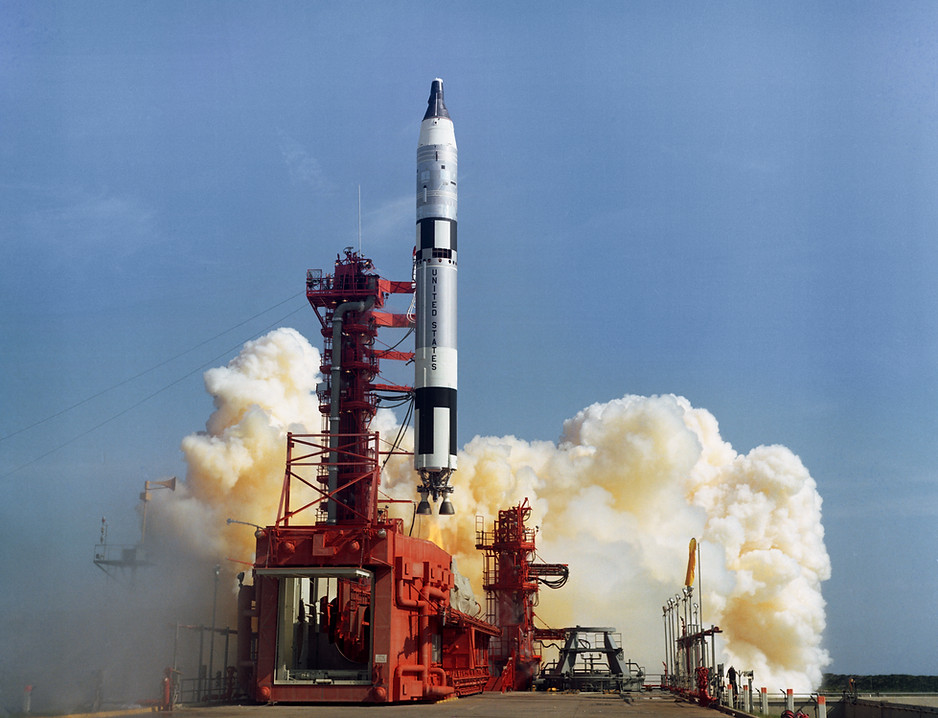The Questar 3.5" embodies the best of
mid-century American innovation & craftsmanship
The Questar Corporation was founded in 1950. After four years of meticulous development, the Questar 3.5" Standard was launched.
Over the next 70 years, the Questar Corporation has continued to refine the Questar optical line to support astronomy hobbyists as well as professional scientific and defense applications. From the company's inception, Questar products continue to be handcrafted in the United States under uncompromising optical quality standards.

The First Telescope in Space
In 1965, mankind ventured to space for the nineteenth time. The Gemini 5 mission was the third crewed Gemini flight and set a world-record for the longest duration in space at the time: 8 days.
In this third flight of the Gemini program, 17 experiments were planned. Experiment D-6 was a test of space photography to determine if an astronaut could identify a specific ground target, point and track the spacecraft at that chosen photographic target and obtain high-resolution imaging.
The optical instrument selected for Gemini 5 was a Questar 3.5" telescope. This was the first high-power telescope in a manned spacecraft!

Mission Transcripts reveal that astronaut "Pete" Conrad was very impressed by the views from his Questar lens. He was the third man to walk on the moon.
The experiment was a success and many of the details were kept classified due to national security implications at the time. The success of the Gemini 5 photographic experiment would lead the way for future collaboration between the Department of Defense (DoD), Central Intelligence Agency (CIA), and NASA on Project UPWARD, the details of which were maintained as TOP SECRET until 2014 when documents were released by the National Reconnaissance Office.
The optical instrumented selected for Project UPWARD?
A Questar 3.5" telescope.
References:
https://historycollection.jsc.nasa.gov/JSCHistoryPortal/history/mission_trans/gemini5.htm
https://www.cia.gov/library/readingroom/docs/CIA-RDP80R01580R002004220017-6.pdf

Some of the optical and photographic pieces of equipment used on the Gemini-5 (NASA).

Cape Canaveral as seen from Gemini-5 and the Questar 3.5" telescope (NASA).
Modern Milestones
The Questar Corporation continued to develop the optical product line by expanding the 3.5" telescope to include ruggedized versions, including industrial optical metrology versions intended for tele-microscopy. Their product line currently includes 7" aperture telescopes and a mid-sized 5" design is in development.
Today, orbiting space telescopes and large ground arrays have replaced the traditional solitary telescope with an astronomer sitting at the eyepiece of the telescope. Though professional astronomy has changed, Questar continues its tradition of supplying the world's leading scientific institutions and continues to support national defense applications.
Company Seven, a telescope and specialty optics retailer and service specialist based in Montpelier, Maryland was chosen to assist NASA with the Hubble Space Telescope Repair Mission. The Questar QM-1 Long Distance Microscope played a critical role in developing and validating the optics used to correct telescopes flawed primary mirror. The optical design of the QM-1 is nearly identical to the Questar 3.5" telescope with modifications implemented to allow close-focus microscopy with 2.7 micron resolution for objects focused as close as 22 inches away.
At the SLAC National Accelerator Laboratory, operated by Stanford University in partnership with the US Department of Energy Office of Science, Questar microscopes are found in several current-generation instruments including the CXI Coherent X-ray Imaging Injector (Questar QM-1 Mk III) and MEC Matter in Extreme Conditions Target Chamber.
The larger 7" optics from Questar have been used to provide video evidence of a Iraqi SCUD missile launcher in Kuwait to the United Nations Security Council for sanction of "Desert Storm" and have supported the United States National Missile Defense System, with the Questar SZ180 telescope supporting the Raytheon Sea Lite Beam Director located at the Army's High Energy Laser Test Facility.
References:
http://www.company7.com/library/questar/queintro.html
http://www.company7.com/c7news/nasa_sts61.html
https://www.questarcorporation.com/surpho.htm
https://lcls.slac.stanford.edu/instruments/mec/components
https://journals.iucr.org/j/issues/2018/01/00/te5021/te5021.pdf

The MEC target chamber at SLAC National Accelerator Laboratory utilizes two computer controlled Questar Long Distance Microscopes. (Stanford)

Astronaut and Physician F. Story Musgrave is seen here working on repairing the Hubble Space Telescope. Dr. Musgrave is the most formally educated astronaut with six academic degrees and only astronaut to have flown aboard all five Space Shuttles. (NASA)

It's still used in space...
Planet Labs, Inc. is a Earth imaging company based out of San Francisco, California that was founded by 3 former NASA scientists. Their entrepreneurial idea was that a fleet of small Earth-observation satellites could provide more useful near real-time views of the globe in contrast to larger and more expensive satellites that could only image a portion of the globe at any time.
While building their first CubeSat in their garage, they chose the Questar 3.5" as the foundation for their optics. Once they entered production, Planet Labs used Questar optics custom housed in Invar, a thermally-stable nickel-iron alloy (rather than Aluminum).
The first and second generation Dove fleets used Questar telescopes.
The Questar CubeSat from Planet Labs offered "3-5 meter resolution" at a build and launch cost of under $1 million. This is impressive when considering Landsat 8, which launched in 2013, and its 15-meter resolution and a development and launch cost of $855 million! Advances in semiconductor manufacturing and communications technology were key reasons how a fleet of Planet Labs Dove satellites could compete against full-scale Earth-imaging satellites -- but it was a Questar that has largely been unchanged in design from the 1950's that met their critical resolution requirements in a small package.
.
References:
https://science.sciencemag.org/content/348/6231/172.full
The upper image is from Landsat (USGS/NASA Landsat).
The Planet Labs Dove was able to photograph a fire in this Brazilian field the following day (bottom image; Planet Labs).
Science
10 Apr 2015: Vol. 348, Issue 6231, pp. 172-177